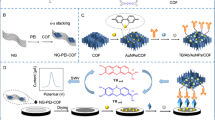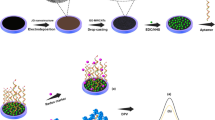Abstract
A novel electrochemical immunosensor was developed for highly sensitive detection of brain-derived neurotrophic factor (BDNF), a well-known depression marker. The immunosensor was fabricated by modifying indium tin oxide-coated polyethylene terephthalate (ITO-PET) with N-doped graphene-polyaniline (NG-PANI) and gold nanoparticles (AuNPs) to enhance the conductivity and protein loading capacity. Subsequently, BDNF was immobilized onto the electrode surface via gold-sulfur bonds, followed by the attachment of biotinylated antibody (Biotin-Ab) and horseradish peroxidase-avidin (HRP-Avidin) to create the final immunosensor (HRP-Avidin–Biotin-Ab-BDNF-AuNPs/NG-PANI/ITO-PET). The proposed immunosensor exhibited a linear range of determination (0.781–400 pg/mL) with a low limit of detection (LOD) of 0.261 pg/mL (S/N = 3) and excellent reproducibility (RSD = 1.4%) and stability (92.7%, RSD = 3.1%). Additionally, the immunosensor demonstrated good anti-interference performance and good recovery (98.1–107%). To evaluate the practical utility of the immunosensor, BDNF levels were quantified in the serum of mice with depression induced by chronic unpredictable mild stress (CUMS). The results indicated that the serum BDNF levels were significantly decreased in the depression model group compared with the control group, highlighting the potential of this immunosensor for clinical detection of BDNF in depression diagnosis and treatment.
Graphical abstract







Similar content being viewed by others
Data availability
The data that support the findings of this study are available from the corresponding author upon reasonable request.
References
Jenkins PE, Ducker I, Gooding R et al (2021) Anxiety and depression in a sample of UK college students: a study of prevalence, comorbidity, and quality of life. J Am Coll Health 69:813–819. https://doi.org/10.1080/07448481.2019.1709474
Koukopoulos A, Sani G (2014) DSM-5 criteria for depression with mixed features: a farewell to mixed depression. Acta Psychiatr Scand 129:4–16. https://doi.org/10.1111/acps.12140
Mitchell AJ, Vaze A, Rao S (2009) Clinical diagnosis of depression in primary care: a meta-analysis. Lancet 374:609–619. https://doi.org/10.1016/s0140-6736(09)60879-5
Keller J, Gomez R, Williams G et al (2017) HPA axis in major depression: cortisol, clinical symptomatology and genetic variation predict cognition. Mol Psychiatry 22:527–536. https://doi.org/10.1038/mp.2016.120
Yuan B, Sun X, Xu Z et al (2020) Influence of genetic polymorphisms in homocysteine and lipid metabolism systems on antidepressant drug response. BMC Psychiatry 20:408. https://doi.org/10.1186/s12888-020-02798-4
Pasquali MA, Harlow BL, Soares CN et al (2018) A longitudinal study of neurotrophic, oxidative, and inflammatory markers in first-onset depression in midlife women. Eur Arch Psychiatry Clin Neurosci 268:771–781. https://doi.org/10.1007/s00406-017-0812-z
Kallies G, Rapp MA, Fydrich T et al (2019) Serum brain-derived neurotrophic factor (BDNF) at rest and after acute aerobic exercise in major depressive disorder. Psychoneuroendocrinology 102:212–215. https://doi.org/10.1016/j.psyneuen.2018.12.015
Sheikh HI, Hayden EP, Kryski KR et al (2010) Genoty** the BDNF rs6265 (val66met) polymorphism by one-step amplified refractory mutation system PCR. Psychiatr Genet 20:109–112. https://doi.org/10.1097/YPG.0b013e32833a2038
Khan MS, Wu GWY, Reus VI et al (2019) Low serum brain-derived neurotrophic factor is associated with suicidal ideation in major depressive disorder. Psychiatry Res 273:108–113. https://doi.org/10.1016/j.psychres.2019.01.013
Primo de Carvalho Alves L, Sica da Rocha N (2018) Lower levels of brain-derived neurotrophic factor are associated with melancholic psychomotor retardation among depressed inpatients. Bipolar Disord 20:746–752. https://doi.org/10.1111/bdi.12636
Moshe H, Gal R, Barnea-Ygael N et al (2016) Prelimbic stimulation ameliorates depressive-like behaviors and increases regional BDNF expression in a novel drug-resistant animal model of depression. Brain Stimul 9:243–250. https://doi.org/10.1016/j.brs.2015.10.009
Dias CT, Curi HT, Payolla TB et al (2020) Maternal high-fat diet stimulates proinflammatory pathway and increases the expression of tryptophan hydroxylase 2 (TPH2) and brain-derived neurotrophic factor (BDNF) in adolescent mice hippocampus. Neurochem Int 139:104781. https://doi.org/10.1016/j.neuint.2020.104781
Lin L, Fu XY, Zhou XF et al (2021) Analysis of blood mature BDNF and proBDNF in mood disorders with specific ELISA assays. J Psychiatr Res 133:166–173. https://doi.org/10.1016/j.jpsychires.2020.12.021
Guo HR, Huang BL, Wang YL et al (2020) Effect of escitalopram on serum GDNF and BDNF levels and 5-HT level of brain tissue of obsessive-compulsive disorder rats. Cell Mol Neurobiol 40:991–997. https://doi.org/10.1007/s10571-020-00788-4
Koyappayil A, Lee MH (2020) Ultrasensitive materials for electrochemical biosensor labels. Sensors (Basel) 21. https://doi.org/10.3390/s21010089
Campuzano S, Yanez-Sedeno P, **arron JM (2020) Revisiting electrochemical biosensing in the 21st century society for inflammatory cytokines involved in autoimmune, neurodegenerative, cardiac, viral and cancer diseases. Sensors (Basel) 21. https://doi.org/10.3390/s21010189
Bakirhan NK, Ozcelikay G, Ozkan SA (2018) Recent progress on the sensitive detection of cardiovascular disease markers by electrochemical-based biosensors. J Pharm Biomed Anal 159:406–424. https://doi.org/10.1016/j.jpba.2018.07.021
Bockaj M, Fung B, Tsoulis M et al (2018) Method for electrochemical detection of brain derived neurotrophic factor (BDNF) in plasma. Anal Chem 90:8561–8566. https://doi.org/10.1021/acs.analchem.8b01642
Akhtar MH, Hussain KK, Gurudatt NG et al (2018) Ultrasensitive dual probe immunosensor for the monitoring of nicotine induced-brain derived neurotrophic factor released from cancer cells. Biosens Bioelectron 116:108–115. https://doi.org/10.1016/j.bios.2018.05.049
Yang X, Wang Y, Qing X (2018) A flexible capacitive pressure sensor based on ionic liquid. Sensors (Basel) 18. https://doi.org/10.3390/s18072395
Palenzuela J, Vinuales A, Odriozola I et al (2014) Flexible viologen electrochromic devices with low operational voltages using reduced graphene oxide electrodes. ACS Appl Mater Interfaces 6:14562–14567. https://doi.org/10.1021/am503869b
Garoz-Ruiz J, Guillen-Posteguillo C, Colina A et al (2019) Application of spectroelectroanalysis for the quantitative determination of mixtures of compounds with highly overlap** signals. Talanta 195:815–821. https://doi.org/10.1016/j.talanta.2018.12.002
Atifi A, Ryan MD (2020) Voltammetry and spectroelectrochemistry of TCNQ in acetonitrile/RTIL mixtures. Molecules 25. https://doi.org/10.3390/molecules25020303
Tian K, Li D, Tang T et al (2018) A novel electrochemiluminescence resonance energy transfer system of luminol-graphene quantum dot composite and its application in H2O2 detection. Talanta 185:446–452. https://doi.org/10.1016/j.talanta.2018.03.064
Wang Y, Sun B, Wei H et al (2022) Investigating immunosensor for determination of depression marker-Apo-A4 based on patterning AuNPs and N-Gr nanomaterials onto ITO-PET flexible electrodes with amplifying signal. Analytica Chimica Acta 1224:340217. https://doi.org/10.1016/j.aca.2022.340217
Qiu HX, Han XB, Qiu FL et al (2016) Facile route to covalently-jointed graphene/polyaniline composite and it’s enhanced electrochemical performances for supercapacitors. Appl Surf Sci 376:261–268. https://doi.org/10.1016/j.apsusc.2016.03.018
Guan X, Kong D, Huang Q et al (2019) In situ growth of a high-performance all-solid-state electrode for flexible supercapacitors based on a PANI/CNT/EVA composite. Polymers-Basel 11. https://doi.org/10.3390/polym11010178
Turemis M, Zappi D, Giardi MT et al (2020) ZnO/polyaniline composite based photoluminescence sensor for the determination of acetic acid vapor. Talanta 211:120658. https://doi.org/10.1016/j.talanta.2019.120658
Qin Q, Zhang R (2013) A novel conical structure of polyaniline nanotubes synthesized on ITO-PET conducting substrate by electrochemical method. Electrochim Acta 89:726–731. https://doi.org/10.1016/j.electacta.2012.11.107
Tian Q, Li Y, Jiang S et al (2019) Tumor pH-responsive albumin/polyaniline assemblies for amplified photoacoustic imaging and augmented photothermal therapy. Small 15:e1902926. https://doi.org/10.1002/smll.201902926
Salahandish R, Ghaffarinejad A, Omidinia E et al (2018) Label-free ultrasensitive detection of breast cancer miRNA-21 biomarker employing electrochemical nano-genosensor based on sandwiched AgNPs in PANI and N-doped graphene. Biosens Bioelectron 120:129–136. https://doi.org/10.1016/j.bios.2018.08.025
Sun DZ, Yu YY, **e RR et al (2017) In-situ growth of graphene/polyaniline for synergistic improvement of extracellular electron transfer in bioelectrochemical systems. Biosens Bioelectron 87:195–202. https://doi.org/10.1016/j.bios.2016.08.037
Cao Y, Yu H, Tan J et al (2013) Nitrogen-, phosphorous- and boron-doped carbon nanotubes as catalysts for the aerobic oxidation of cyclohexane. Carbon 57:433–442. https://doi.org/10.1016/j.carbon.2013.02.016
**n Q, Shah H, **e W et al (2021) Preparation of blue- and green-emissive nitrogen-doped graphene quantum dots from graphite and their application in bioimaging. Mater Sci Eng C Mater Biol Appl 119:111642. https://doi.org/10.1016/j.msec.2020.111642
Paramo E, Palmero S, Heras A et al (2018) Carbon nanostructured films modified by metal nanoparticles supported on filtering membranes for electroanalysis. Talanta 178:736–742. https://doi.org/10.1016/j.talanta.2017.10.019
Jouyban A, Rahimpour E (2020) Optical sensors based on silver nanoparticles for determination of pharmaceuticals: an overview of advances in the last decade. Talanta 217:121071. https://doi.org/10.1016/j.talanta.2020.121071
Rao H, Chen M, Ge H et al (2017) A novel electrochemical sensor based on Au@PANI composites film modified glassy carbon electrode binding molecular imprinting technique for the determination of melamine. Biosens Bioelectron 87:1029–1035. https://doi.org/10.1016/j.bios.2016.09.074
Diaz-Caballero M, Navarro S, Ventura S (2021) Functionalized prion-inspired amyloids for biosensor applications. Biomacromol 22:2822–2833. https://doi.org/10.1021/acs.biomac.1c00222
Yang H, Zhang Q, Liu X et al (2020) Antibody-biotin-streptavidin-horseradish peroxidase (HRP) sensor for rapid and ultra-sensitive detection of fumonisins. Food Chem 316. https://doi.org/10.1016/j.foodchem.2020.126356
Antoniuk S, Bijata M, Ponimaskin E et al (2019) Chronic unpredictable mild stress for modeling depression in rodents: meta-analysis of model reliability. Neurosci Biobehav Rev 99:101–116. https://doi.org/10.1016/j.neubiorev.2018.12.002
Elfving B, Plougmann PH, Wegener G (2010) Detection of brain-derived neurotrophic factor (BDNF) in rat blood and brain preparations using ELISA: pitfalls and solutions. J Neurosci Methods 187:73–77. https://doi.org/10.1016/j.jneumeth.2009.12.017
Syritski V, Öpik A, Boroznjak R et al (2019) Advanced sensing materials based on molecularly imprinted polymers towards develo** point-of-care diagnostics devices. Proc Estonian Acad Sci 68. https://doi.org/10.3176/proc.2019.2.07
Xu H, Luo J, Wang Y et al (2017), Label-free electrochemical detection of brain-derived neurotrophic factor based on a novel immune microelectrode array, 2017 IEEE 17th International Conference on Nanotechnology (IEEE-NANO), pp 584–589
Yoo YK, Lee J, Kim J et al (2016) Ultra-sensitive detection of brain-derived neurotrophic factor (BDNF) in the brain of freely moving mice using an interdigitated microelectrode (IME) biosensor. Sci Rep 6:33694. https://doi.org/10.1038/srep33694
**e X, Liu D, Wang W et al (2023) Microelectrode-based electrochemical impedance determination of brain-derived neurotrophic factor in aqueous humor for diagnosis of glaucoma. Anal Chem 95:2087–2093. https://doi.org/10.1021/acs.analchem.2c05033
Acknowledgements
This work was supported by the National Natural Science Foundation of China (81972018), the major science and technology project of Gansu Province (21ZD4FA013), the People’s Livelihood Special Project from Technical Innovation Guide Plan of Gansu Province (20CX4FK014), the Key Talent Project of Organization Department of Gansu Provincial Party Committee ([2022] Gan-71), the Central Government Guiding Local Science and Technology Development Fund Project (22ZY1QA012), the Special Project of Science and Technology Commissioner of Gansu Province (22CX8GA009), and the Talent Innovation and Entrepreneurship Project of Lanzhou (2017-RC-115, 2020-RC-41).
Author information
Authors and Affiliations
Corresponding authors
Ethics declarations
Conflict of interest
The authors declare no competing interests.
Additional information
Publisher's note
Springer Nature remains neutral with regard to jurisdictional claims in published maps and institutional affiliations.
Supplementary Information
Below is the link to the electronic supplementary material.
Rights and permissions
Springer Nature or its licensor (e.g. a society or other partner) holds exclusive rights to this article under a publishing agreement with the author(s) or other rightsholder(s); author self-archiving of the accepted manuscript version of this article is solely governed by the terms of such publishing agreement and applicable law.
About this article
Cite this article
Wei, H., Sun, B., Li, Y. et al. Electrochemical immunosensor AuNPs/NG-PANI/ITO-PET for the determination of BDNF in depressed mice serum. Microchim Acta 190, 330 (2023). https://doi.org/10.1007/s00604-023-05878-w
Received:
Accepted:
Published:
DOI: https://doi.org/10.1007/s00604-023-05878-w




